Judi Lynn
Judi Lynn's JournalColombia's media pretending hugely popular series on Uribe doesn't exist
by Adriaan Alsema June 27, 2020
Colombia’s media are pretty much pretending that “Matarife,” the hugely successful online series on former President Alvaro Uribe, does not exist.
Last week’s episode on the evidence Uribe did favors to the Medellin Cartel drew an astonishing million visitors, but wasn’t news worthy to the country’s media.
The claim of Daniel Mendoza that he has been on the run and is fearing for his life didn’t even trigger press freedom foundation FLIP to speak out in his defense.
Priority #1: character assassination
Daniel Mendoza
The opinion pieces that have appeared in media have solely been dedicating themselves to discrediting the series and its maker.
. . .
Priority #2: Judicial harassment
Pundits and politicians tied to the mafia have begun filing criminal charges against Mendoza, who broke the rule that you don’t reveal evidence of Uribe’s ties to the Medellin Cartel.
Doing so has been getting people killed since the assassination of Justice Minister Rodrigo Lara in 1984 who discovered that a Uribe family helicopter was found at a cartel cocaine factory in southern Colombia.
More:
https://colombiareports.com/colombias-media-pretending-hugely-popular-series-on-uribe-doesnt-exist/
Reexamining the Mythology of the Tarahumara Runners
A decade after 'Born to Run' made them famous, anthropologists take another look

Alex Hutchinson
Jun 25, 2020
You remember the Tarahumara, right? They are, as Christopher McDougall memorably described them in Born to Run back in 2009, the “near-mythical tribe of Stone Age superathletes” who live in the canyons of northwestern Mexico and run astounding distances over vertiginous terrain without even breaking a sweat.
Born to Run also introduced the wider world to a Harvard anthropologist and evolutionary biologist named Daniel Lieberman, whose research on the evolutionary origins of running led him to hypothesize that even modern humans would be better off running either barefoot or with minimally supportive shoes. Colorful tales of the Tarahumara mixed with Lieberman’s scientific cred made for a potent combination, and interest in barefoot and minimalist running exploded after the publication of McDougall’s book.
In the years since, there have been critical reappraisals of the case for minimalist running. Now, in an article in the journal Current Anthropology titled “Running in Tarahumara (Rarámuri) Culture: Persistence Hunting, Footracing, Dancing, Work, and the Fallacy of the Athletic Savage,” a team of anthropologists take aim at the myths and misunderstandings that have arisen over Tarahumara running culture. The lead author? None other than Daniel Lieberman.
In scientific circles, Lieberman is probably most famous for a paper he published in 2004 with Dennis Bramble of the University of Utah, arguing that humans evolved to run long distances. (The tag on the cover of that issue of Nature: “Born to Run.”) In this telling, our ability to run large animals to exhaustion over many hours or even days drove—and was enabled by—a series of crucial adaptations ranging from shorter toes to a profusion of sweat glands. It was this interest in persistence hunting that initially sent Lieberman and his colleagues to the Copper Canyon in Mexico, where stories of Tarahumara chasing down deer have captivated visiting adventurers and scientists since the 1800s.
More:
https://www.outsideonline.com/2415104/tarahumara-runners-study
Also posted in Anthropology:
https://www.democraticunderground.com/12295759


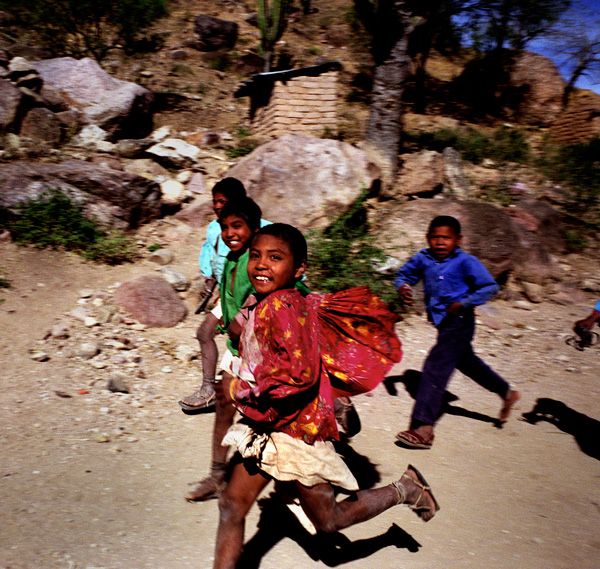



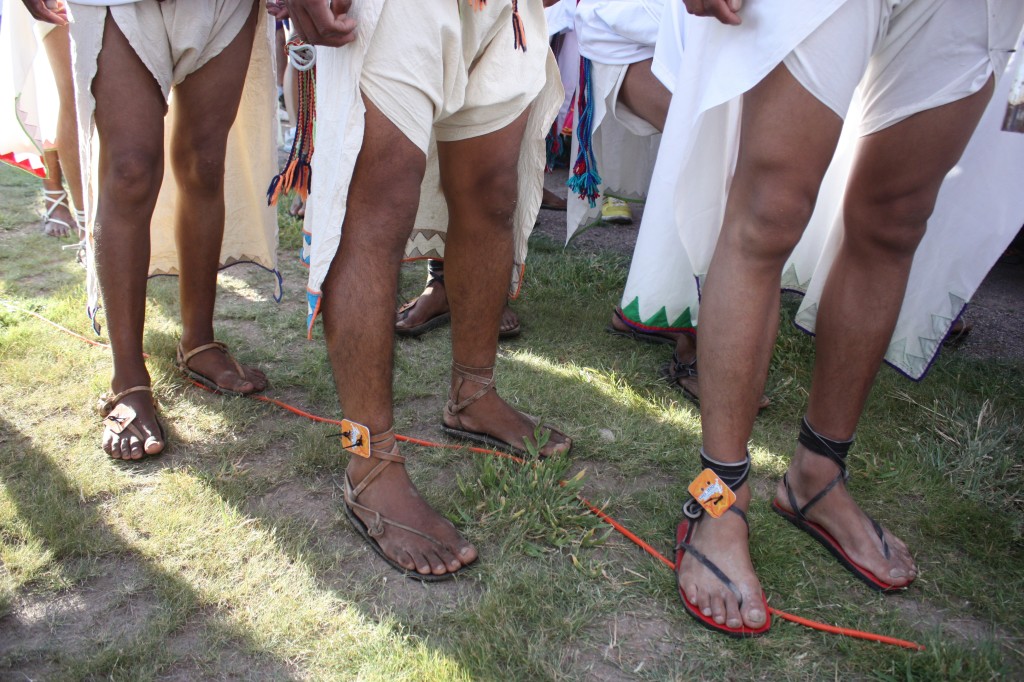

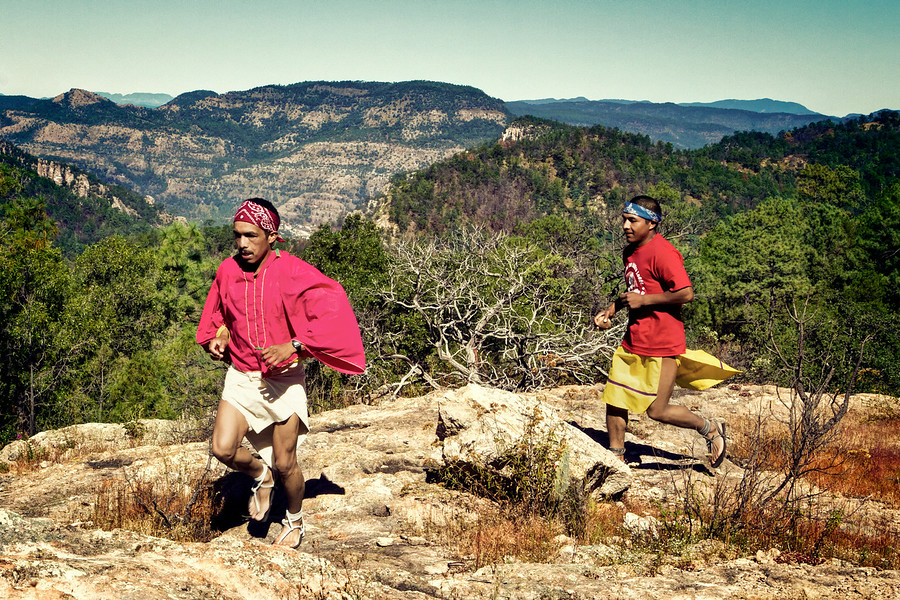
PNP 'Gravely Concerned' About Gov't Silence As US Takes Aim At Cuba
Source: Jamaica Gleaner
PNP ‘Gravely Concerned’ About Gov’t Silence As US Takes Aim At Cuba - Party Wants Administration To Issue Statement Condemning Bill Targeting Medical Missions
Published:Friday | June 26, 2020 | 12:14 AM

The People’s National Party said it is “gravely concerned” that the Government has not yet made a statement on the attempt by the United States to introduce legislation targeting countries that hire Cuban healthcare workers through medical missions.
For decades, the health capacities in Jamaica and other Caribbean countries have been bolstered by Cuban professionals.
Republican Senator Rick Scott led the introduction of the Cut Profits to the Cuban Regime Act last Wednesday in the US Senate.
The bill will seek to classify the humanitarian engagements by Cuba as a form of human trafficking and has the potential to be a factor when ranking countries in its annual Trafficking in Persons report.
“The Cuban people have always stood with the people of Jamaica in challenging times, from the 1970s through to today’s COVID-19 pandemic crisis, when over 140 medical professionals arrived from Cuba to bolster our country’s response to the outbreak of COVID-19,” said Opposition Spokesman on Health Dr Morais Guy.
Read more: http://jamaica-gleaner.com/article/news/20200626/pnp-gravely-concerned-about-govt-silence-us-takes-aim-cuba-party-wants
'Uribe ordered Colombia's VP to appoint terrorist group's ideologue'

Jose Miguel Narvaez (Image: RCN Radio)
by Adriaan Alsema June 25, 2020
Former President Alvaro Uribe allegedly ordered Colombia’s vice-president to appoint an ideologue of what the US government considered a terrorist organization a top government position.
Jose Miguel Narvaez told the Supreme Court he joined Uribe’s 2002 government formation team despite being the ideologue of the AUC, a paramilitary organization designated a terrorist group by the US government the year before.
This government formation team was led by Fabio Echeverri, a close ally of Uribe and the father of Luis Guillermo Echeverri, a close friend of President Ivan Duque.
Before taking office in August 2002, Uribe ordered Vice-President Marta Lucia Ramirez to hire Narvaez as her personal advisor at the Defense Ministry, court documents released by news website Minuto 30 show.
More:
~ ~ ~
Google translation from Las Orillas:
José Miguel Narváez the DAS man who spoke to Carlos Castaño in his ear
He came to his Las Tangas farm with the list of those who had to kill. A judge sentenced him to 30 years in prison for the murder of Jaime Garzón
By: Iván Gallo | August 12, 2015

Three days before he was killed, Jaime Garzón entered the Modelo prison in Bogotá to meet with paramilitary chief Ángel Custodio Gaitán. The reason for the interview was to beg for his life since the journalist was certain that he had entered Carlos Castaño's blacklist. Gaitán did not give him false hopes and told him abruptly that stopping that order was very difficult; the pattern was like God, what he said, he fulfilled it.
On August 13, 1999, at 5:45 in the morning, Jaime Garzón realized that his fears were not unfounded: two hitmen belonging to the La Terraza gang, previously hired by Carlos Castaño, shot him at the last stoplight. separated from its destination, the offices of the Radionet station. DAS officials quickly arrived at the crime scene to prepare the sainete: they hired a neighbor from the place, named María Amparo Arroyabe, who pointed out Juan Pablo Ortiz Agudelo alias Bochas and Edilberto Antonio Sierras, two small-time criminals who would now have to go to jail and be the object of national repudiation for a crime they did not commit.
The country knew that Garzón was going to be killed by the self-defense groups. Not only his television jokes, which enraged Carlos Castaño and the rarefied military leadership of the time, but the humanitarian management that he was carrying out with the government of Cundinamarca for the liberation of kidnapped in the power of the ELN, a work much more effective than the crude attempts Made by the Gaula or the Army to rescue the hostages, and General Mora Rangel's irresponsible hints that the humorist was a guerrilla sympathizer, they were facts that made him too visible a target.
The idea of killing him had emerged a year ago, in 1998. At that time, the paramilitary project was beginning to prevail in Colombia with the approval of high-ranking state officials and army generals. The idea was not only to physically prepare the combatants to face their red rivals, but also ideologically. One of the most outstanding teachers in this field was José Miguel Narváez, a tough, studied and convincing instructor from the Escuela Superior de Guerra, who earned the respect and admiration of the paramilitary chiefs for his chair entitled Why is it legal to kill communists? In colombia?
Classes were held between a relaxed and festive atmosphere in Urabá, on the farms La Veintiuno and La Quince, both owned by Carlos Castaño. Amalfi's illustrious son loved the erudition with which he handled the subject of the anti-communist struggle. So, one day before the talk began, he ordered steers to be killed and he made a roast pantagruélico in order to entertain his master. They even said that this reserve officer had an office right there, on the La Twenty-one farm, at the disposal of his friends, the Paracos.
To the meetings that took place in these farms, Narváez almost always carried a sheet of paper with the profiles of the probable insurgents that Castaño should take out of the way. The files of Álvaro Leyva Durán, Wilson Borja, Manuel Cepeda Vargas, Piedad Córdoba and Jaime Garzón came into his hands. On killing the latter, doubts arose for the Paramilitary chief. He was a public figure, loved by all Colombians. Although El fantasma hated the program in which Garzón joked and joked denounced the atrocities that the paramilitary project was beginning to perpetrate throughout the national territory, he was still an innocent humorist.
. . .
Three days before his death, Jaime learns that he is going to be killed. In addition to going to the Modelo prison to speak with Custodio Gaitán, he communicates with the then Minister of Defense, Rafael Pardo, searches, unsuccessfully, for General Jorge Enrique Mora and manages to speak with Rito Alejo del Río. Garzón knew which were the military that supported the paramilitary cause and yet he could do nothing to save himself.
Apparently Castaño regretted this death and as a result of it he ceased to trust Narváez's suggestions and advice. DAS did its part and diverted the investigation with its false witnesses and its long-standing suspects. For José Miguel Narváez this was not the beginning of the end; on the contrary, it was the beginning of a dizzying ascent.
. . .
Shortly before Andrés Pastrana handed over his presidency, Narváez would become an advisor to the Ministry of Defense, a position in which he would not last long because of a call interception scandal. Thanks to his friendships, this man managed to fall while standing; Ex-director of the DAS Jorge Noguera Cote tells that one of the first orders that Álvaro Uribe Vélez gave, when sitting in the solitude of Bolívar, was to appoint Narváez as deputy director of intelligence of the DAS despite his extensive record. There, he was again linked to irregularities such as the scandal of the persecutions and telephone bullets against government opponents, a crime for which he was arrested in late 2010.
. . .
The comedian's death coincided with a change in the country's power structures: the traditional ruling class would make way for paramilitarism. It did not take a coup d'état, but rather the co-opting of votes, the rigging of some senators, the timely delivery of a ticket envelope or a threat. In this change of skin, the murderous bullets threw intellectuals and social activists of the stature of Eduardo Umaña Mendoza, Mario Calderón, José María Valle, Darío Betancourt, Elsa Alvarado and so many other journalists, politicians and thinkers who no longer fit. in the country model that was making its way.
Jaime's was the most painful homicide because we all knew him. Knowing who his murderers were will help to lessen the pain that seems eternal. The fact that this crime does not go unpunished will undoubtedly help the final reconciliation.
https://www.las2orillas.co/la-catedra-anticomunista-de-los-paras-determino-el-asesinato-de-jaime-garzon/
~ ~ ~

Jaime Garzón's car, where it was attacked by sicaros.



He was known to wrap himself in the flag.
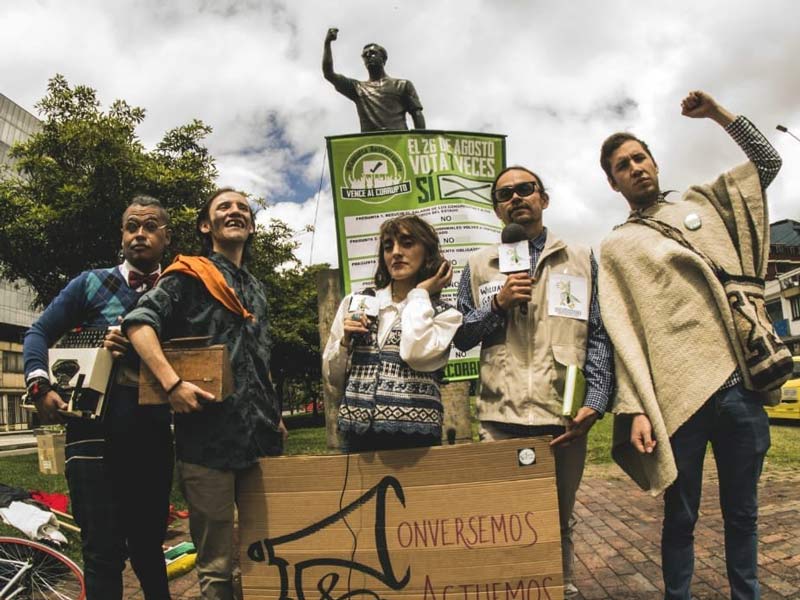
People standing at one of the memorials for Jaime Garzón. Some of the men have shoe shine kits in memory of one of his famous recurring TV skit in which he would play the part of a shoe shine man in whose chair various famous Colombian people would sit for dialogue.
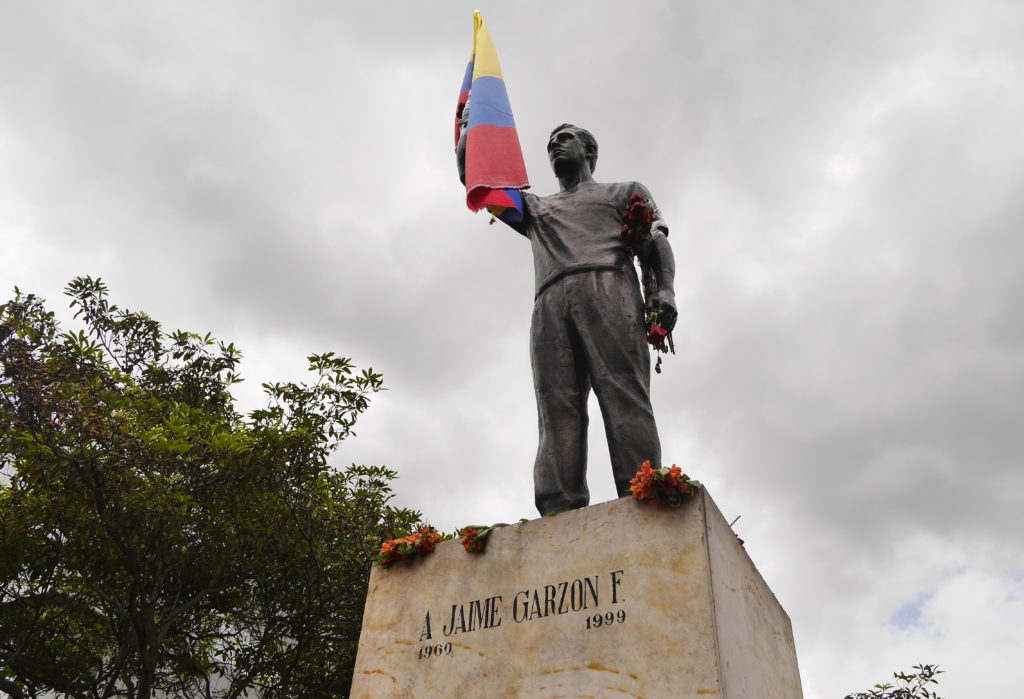
One of the memorials.
The Bogotá Post:
"Jaime Garzón: The day the laughter stopped"




All this because the fascist government didn't like him. Quite the waste, wasn't it?
The whole country loved him, except for the monsters.
Peru threatens temporary takeover of private clinics over coronavirus fees
JUNE 24, 2020 / 6:28 PM / UPDATED 4 HOURS AGO
2 MIN READ
LIMA (Reuters) - Peru’s President Martín Vizcarra threatened on Wednesday to temporarily take over the country’s private healthcare clinics if they failed to strike a deal with the government in 48 hours over fees for treating coronavirus patients.
Private clinics have for three weeks wrangled with Vizcarra’s government over a fair rate for care. The haggling began amid reports of overcharging for the sickest patients who require mechanical ventilators and intensive care.
“We cannot wait indefinitely,” said Vizcarra in a televised speech together with his cabinet of ministers. “With the law and the Constitution on our side we can do it.”
Vizcarra said he would invoke an article in the constitution that allows the government to expropriate private property for national security purposes. The constitution requires “just compensation” for any such takings.
More:
https://uk.reuters.com/article/uk-health-coronavirus-peru/peru-threatens-temporary-takeover-of-private-clinics-over-coronavirus-fees-idUKKBN23V3EB
Unusual Friendship Between Wolf And Bear Documented By Finnish Photographer
ANIMALS, PEOPLE 4 YEARS AGO
“It’s very unusual to see a bear and a wolf getting on like this” says Finnish photographer Lassi Rautiainen, 56, who took these surprising photos. The female grey wolf and male brown were spotted every night for ten days straight, spending several hours together between 8pm and 4am. They would even share food with each other.
“No-one can know exactly why or how the young wolf and bear became friends,” Lassi told the Daily Mail. “I think that perhaps they were both alone and they were young and a bit unsure of how to survive alone…It is nice to share rare events in the wild that you would never expect to see.”
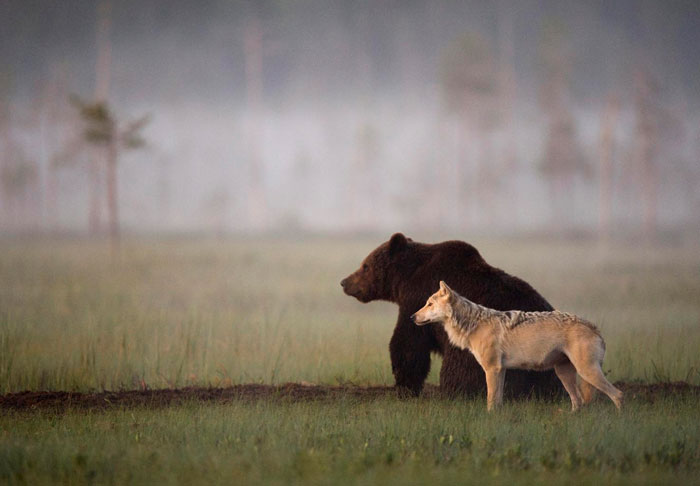
This unlikely pair was spotted by Finnish photographer Lassi Rautiainen
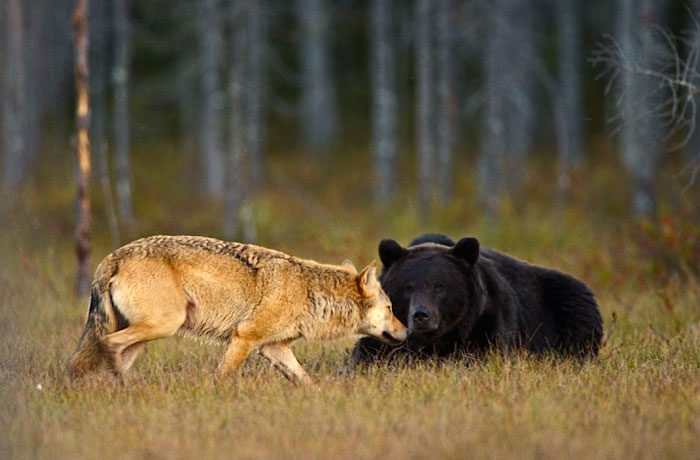
He photographed the female grey wolf and male brown bear every night for ten days straight

“No one had observed bears and wolves living near each other and becoming friends in Europe”
More:
https://www.boredpanda.com/bear-friend-wolf-lassi-rautiainen/?utm_source=google&utm_medium=organic&utm_campaign=organic
Fearing death and prison, maker of popular series on Uribe into hiding
by Adriaan Alsema June 23, 2020
The maker of Colombia’s most popular online series, Matarife, has gone into hiding, fearing his series on former President Alvaro Uribe could get him killed or thrown in jail.
Lawyer and journalist Daniel Mendoza didn’t break the law, he broke the rule about staying quiet about the former president’s ties to the now-defunct Medellin Cartel and paramilitary death squads.
When Mendoza announced Matarife would “morally do away with Uribe,” everybody in Colombia knew the series would get Mendoza in trouble, but not that the online series would become one of the biggest YouTube hits in Colombian history.
The former president tried to prevent the series from airing, but failed. Months before the first episode of his series hit 5 million views, the attorney and journalist had gone into hiding afraid he would be assassinated, Mendoza said on Saturday.
More:
https://colombiareports.com/fearing-death-and-prison-maker-of-popular-series-on-uribe-has-gone-into-hiding/
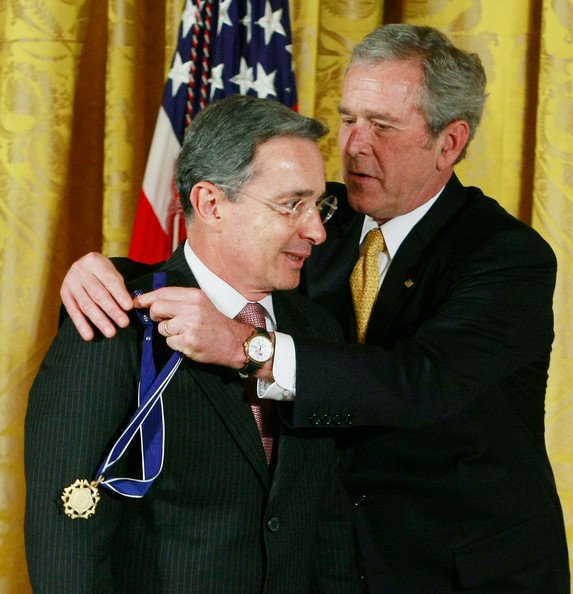

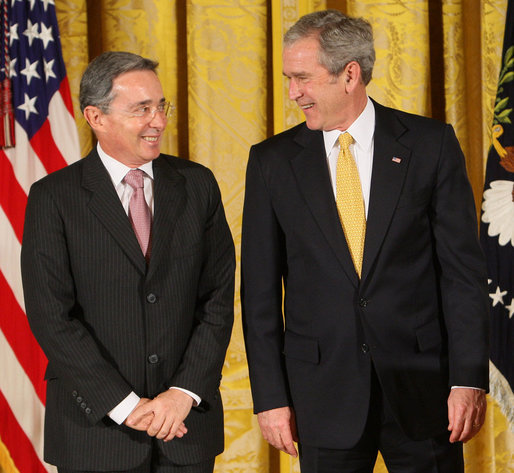
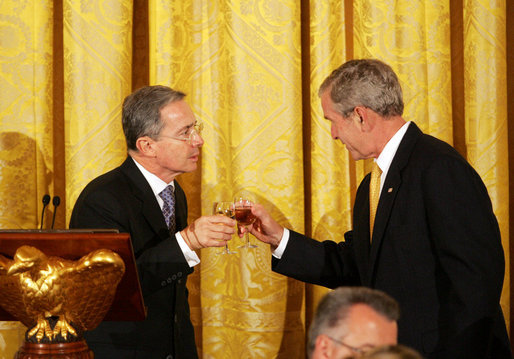

Investigation Keeps Work of Silenced Journalists Alive
By Federica Marsi | 18 hours ago
From the “sand mafia” in India to the ferronickel industry in Guatemala and gold mining in Tanzania, journalists who pull back the curtain on extractive industries are being silenced.
. . .
Pollution and Protesters in Guatemala

A mining plant in Guatemala. Photo: Forbidden Stories
In 2011, an international mining and metals group arrived in a remote municipality nestled in the hills of eastern Guatemala. It took over a ferronickel mine which sold the alloy of iron and nickel to numerous international steel manufacturing companies, operating the mine through its local subsidiary.
A local indigenous group, the Maya Q’eqchi’ community, claimed the mine was responsible for polluting the lake and cutting down the region’s giant forest. Residents in the community said they were able to see an orange dust cloud spreading in the sky where trees once stood.
On May 27, 2017, as enraged protesters hurled stones at the police, fisherman Carlos Maaz was shot dead. The Guatemalan authorities denied anyone had died, despite a local journalist with the local news website Prensa Comunitaria, Carlos Choc, capturing Maaz’s lifeless body on camera.
The journalist went on air to report from the scene and later began receiving threats. A criminal investigation was launched against him and he went into hiding. (Choc, who faces an ongoing legal case, had his home broken into and equipment stolen in April, in what he believes to be an ongoing attempt to intimidate him.)
More:
https://gijn.org/2020/06/22/investigation-keeps-work-of-silenced-journalists-alive/
It's Not Just Covid That Has Hondurans Starving. It's Also U.S. Policy.
JUNE 22, 2020
On the roots of the Honduran hunger crisis.
BY MEGHAN KRAUSCH
The spread of Covid-19 is terrifying in Honduras, where the healthcare system has been decimated by corruption and defunding. But when I talked to contacts in Honduras, the first concern on their mind was hunger. Honduran human rights lawyer Prisila Alvarado Euceda tells me “at this point,” people in Honduras are “suffering a famine.” Alvarado says that during the three months that Honduras has restricted movement at gunpoint based on identity card number—including trips to grocery stores, pharmacies and work—many people “have not received any food from the state.” Melisa Martinez is an organizer with the Black Fraternal Organization of Honduras (OFRANEH), in another part of the country: Punta Gorda, Roatán, Melisa Martinez. She tells me, “The hunger, in my view, is fatal.”
Honduras has been under strict lockdown since March. This has meant almost total restriction of poor people’s ability to go out and seek work, while the wealthy and people connected to the current government seem able to flout the order at will. As in the United States, shelter-in-place orders have not been accompanied by robust social programs to ensure that people are able to eat and pay rent while staying at home. In a country where 48.3% of people live in poverty, including 16.5% who live in what is considered “extreme poverty,” and more than 70% rely on work in the informal sector, the effects of the lockdown for ordinary Hondurans have been devastating. “If we don’t die of Covid, we will die of hunger,” Albertina López Melgar, one of the general coordinators of the Broad Movement for Dignity and Justice (MADJ) tells me.
Yet hunger is no more a product of natural forces than the palm plantations that have replaced the bananas along the northern coast. From early 20th century military intervention on behalf of banana companies to recent support for a right-wing coup, the U.S. neocolonial relationship with Honduras has a direct hand in driving hunger and poverty. Despite the context of risk, organizers are stepping in to fill the gaps, modeling powerful forms of food security and sovereignty in the midst of tremendous hardship. López points to the fact that President Juan Orlando Hernández had millions of Honduran lempiras allocated for aid to citizens during the lockdown at his disposal, yet the people have received neither food nor medicine. She put it this way: “The people have received nothing, and when they go out to protest for food what they receive is repression.” In a separate interview, Alvarado, a lawyer and member of a group of women defenders of environmental and human rights in El Progreso, Yoro, highlighted that the United States has consistently been implicated in bankrolling and manufacturing the weapons used to repress Hondurans who take to the streets demanding their rights, including in recent demonstrations for food.
Arguing that the basic structure of the Honduran economy remains the same since the days of the powerful banana companies, Corie Welch, coordinator of the Solidarity Collective Honduras Program, says, “This creation and perpetuation of poverty in Honduras has led to massive amounts of hunger in Honduras and this is intentional—it’s not something that happened by chance.”
The original banana republic
Forty-nine years ago, Uruguayan novelist Eduardo Galeano wrote, “The Koran mentions the banana among the trees of paradise, but the ‘bananization’ of Guatemala, Honduras, Costa Rica, Panama, Colombia and Ecuador suggests that it is a tree of hell.” In the early 20th century, United Fruit (now Chiquita) received military assistance from the United States to steal public land and install a more U.S.-friendly government in Honduras. O. Henry, author of “The Gift of the Magi,” coined a term for supposedly unstable countries governed by proxy by the United States: the “banana republic.”
More:
http://inthesetimes.com/article/22615/honduras-covid-us-neocolonialism-hunger-crisis-national-party
Panama exhumes 19 bodies in search of victims of 1989 U.S. invasion
JUNE 21, 2020 / 8:13 AM / UPDATED 11 HOURS AGO
Panama exhumes 19 bodies in search of victims of 1989 U.S. invasion
Elida Moreno
2 MIN READ
MEXICO CITY (Reuters) - Panamanian authorities this week finalised the exhumation of 19 bodies in a private cemetery in Panama City as part of a search for victims of the 1989 invasion by the United States, Panamanian judicial authorities said.
The bodies were exhumed from the Jardín de Paz cemetery in the capital, where they were buried 30 years ago after initially being dumped in mass graves during the December 1989 to January 1990 invasion. Some bodies remain unidentified.
The corpses were dug up at a site holding about 100 graves of those died during the U.S. military operation that led to the deaths of at least 500 Panamanians and marked the end of the dictatorship of General Manuel Noriega.
About 300 civilians died in the assault, according to official estimates. Only 23 American soldiers lost their lives.
But human rights organizations have long estimated the true number of Panamanian victims could be higher, prompting the government of Juan Carlos Varela to establish a commission to investigate the death toll.
More:
https://uk.reuters.com/article/uk-panama-usa/panama-exhumes-19-bodies-in-search-of-victims-of-1989-u-s-invasion-idUKKBN23S0HN?rpc=401&
~ ~ ~
From Wikipedia, the free encyclopedia
The Panama Deception
Directed by Barbara Trent
Written by David Kaspar
Narrated by Elizabeth Montgomery
Music by Chuck Wild
Cinematography Manuel Becker
Michael Dobo
Production
company
Empowerment Project
Distributed by Empowerment Project
Release date
July 31, 1992
Running time
91 minutes
Country United States
Language English
The Panama Deception is a 1992 American documentary film that won the Academy Award for Best Documentary Feature.[1] The film is critical of the actions of the U.S. military during the 1989 invasion of Panama, covering the conflicting reasons for the invasion. It also highlighted media bias within the United States, showing events that were unreported or systematically misreported, including downplaying the number of civilian casualties. It was directed by Barbara Trent, written and edited by David Kasper, and narrated by actress Elizabeth Montgomery. It was a production of the Empowerment Project.
The film asserts that the U.S. government invaded Panama primarily to destroy the PDF, the Panamanian Defense Forces, who were perceived as a threat to U.S. control over Panama, and to install a government friendly to U.S. interests. The film includes footage of mass graves uncovered after the American troops had withdrawn, burned down neighborhoods, alludes to the use of beam and other experimental weapons, as well as depictions of some of the 20,000 refugees who fled the fighting.
https://en.wikipedia.org/wiki/The_Panama_Deception
~ ~ ~
Profile Information
Member since: 2002Number of posts: 160,527